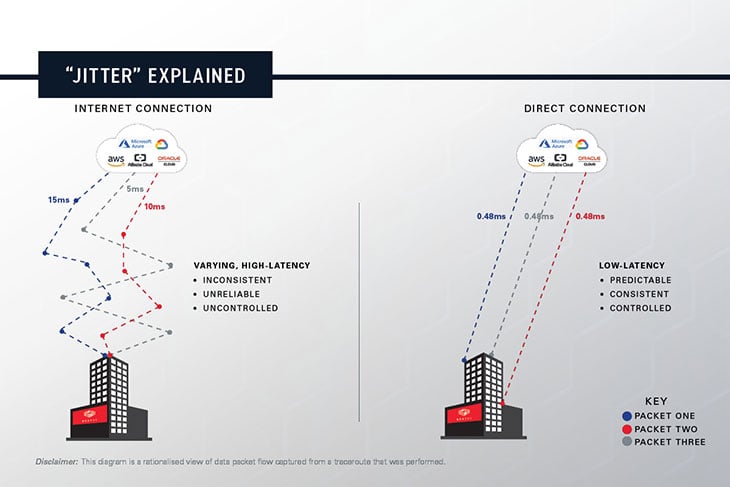Written by: Adam Gardner, Head of Products
For many organisations, the perception that a company only connects to a small and carefully controlled number of public clouds is often not true. When a thorough audit peels the lid off the sardine tin, it invariably shows organisations are squeezing in more than they thought.
If you dive deeper into your IT toolkit, you’ll no doubt find you’re using a wide range of cloud-based applications every day to support your operations. This includes Office 365, Microsoft Teams, Salesforce, Slack, SAP, Dropbox, Zoom, AWS, Google Cloud, Oracle and many others.
In fact, each of us uses a vast array of different cloud services every day. Each of those may only function as a small percentage of our daily processes, but if any of them are down or underperforming, the time wasted trying to troubleshoot or workaround the problem quickly adds up across the organisation. Often these systems are situated within a workflow, so individually it is an annoyance, but cumulatively it can negatively impact productivity, output and work satisfaction.
So, if you’re using multiple clouds on a daily basis, how do you ensure these clouds are performing optimally and keeping your productivity levels high?

Speed: it will make or break you
Depending on where you’re connecting, a latency performance difference may only be milliseconds, but this can compound and become significant. When it comes to digital experience, those fractions of a second in extra latency can have a very real impact on network performance and customer experience.
Recent tests conducted by NEXTDC on our own Multi-Cloud architecture demonstrated that, on average, the data round trip time (RTT) decreased by as much as 66% when comparing direct connections to cloud, versus connectivity to clouds via the public Internet.
Think about it like this. Imagine a shopping cart experience on your website. The e-commerce engine sits in AWS, your customer database sits in Microsoft Azure, your financials are in Oracle Cloud and your inventory and ERP systems are on premise. All these systems need to work together in real time to successfully complete a transaction and keep your customer happy.
If for example the RTT latency from your on-premises data centre to the cloud is 20ms, then it could easily take as much as 10x or 200ms to process and complete a transaction as multiple reads and writes are required in each system. If there are bandwidth constraints due to higher levels of traffic to your website, it could take even longer to process.
Putting a dollar figure on poor application performance has historically been difficult, however, tech giants have been able to quantify it. Greg Linden, now a Data Scientist at Microsoft, worked on performance testing at both Google and Amazon and can equate slowness to a real dollar value. His results were incredible: each 100ms that Amazon.com was slowed down resulted in a measurable drop of 1% of sales in A/B testing (where a control group gets the usual experience, and another group gets the modified site). The lesson here? Speed matters. Customers do not like to wait. So why make them?
How Jitter destroys performance
Jitter is the variation in latency each packet experiences. This happens when packets are being routed across uncontrolled public Internet routes, where packets bounce from network to network until they finally reach the destination. Each packet doesn’t necessarily take the same route – it will go wherever internet protocols determine is the best route at that precise moment.
If the first packet takes 50ms, the second 80ms and the third 40ms, there’s a high likelihood the first and third packet will arrive before the second one does. When data is received out-of-order at the other end, it puts software under pressure which has a noticeable effect on application performance.
Video conferencing and voice calls, for example, are heavily impacted by jitter. When you see the picture freezing or breaking up, or voices dropping out for a moment, that’s more often due to jitter, not lack of bandwidth. Software has trouble dealing with out-of-order packets. Strategies like buffering are needed to attempt to overcome that, to give the software time to reassemble the packets in the right order. Unfortunately, the very high-performance hardware needed for network buffering is expensive and has physical limitations.
Being directly interconnected to a cloud provider through a colocation data centre provider like NEXTDC, virtually eliminates network jitter altogether because your direct path is private and always the same.

Translating connectivity performance into productivity
Most businesses are deeply reliant on cloud applications, yet don’t realise how small inefficiencies in their architecture can all compound to reduce the productivity of their entire workforce.
As an organisation, do you want to be paying your team members to sit and wait for things to happen? Or do you want to be making the right architectural choices to let your team get on with productive work?
The bottom line is that optimised interconnectivity removes friction across the whole workforce and is also key to improved customer experience. The holy grail that every organisation is chasing.
If improving connectivity architecture is something you are interested in, our team of experts are here to help.


